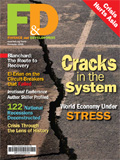 View this Issue Archive of F&D Issues Subscribe to Print Edition Write to us F&D welcomes comments and brief letters, a selection of which are posted under Letters to the Editor. Letters may be edited. Please send your letters to: fanddletters@imf.org. F&D Magazine Free Email Notification Receive emails when we post new
items of interest to you. |
Natalie Ramirez-Djumena and Jair Rodriguez The Ingredients of Sustained High Growth Since 1950, 13 economies have managed to grow at an average rate of 7 percent or more for at least 25 years in a row. How did they do it? And, more important, can such high growth be repeated in other countries on a sustained basis? For over two years, these were the questions that guided the work of the Commission on Growth and Development, comprising leaders from business, government, and academia, including two Nobel laureates. Diversified and engaged Since economies can learn faster than they can invent, developing countries can catch up through much faster growth than was experienced by today's industrialized countries when they were creating their own growth levers. Even with high rates, catching up is a long-term process that takes two generations or more. Critical to success is engagement with the global economy that enables developing countries to import knowledge and technology, to access markets, and to generate a strong export sector, which is especially important in the early stages of growth.
The five common characteristics of sustained high growth These 13 countries also relied on markets, including mobility of labor, to allocate resources. And strong leadership—in the form of individuals, parties, or political systems—forged a consensus around the goals of growth and development, and ensured the process was inclusive and fair in terms of opportunities.
How did they do it? It is not easy—or common—for middle-income countries to reach high income. The first priority for policymakers is to anticipate this transition and the new demands it will make of them. Korea, for example, changed its policies and public investments in the 1980s and the 1990s to help the economy's evolution from labor-intensive manufacturing to a more knowledge- and capital-intensive economy. The second priority is for countries to let go of some of their earlier policies, even the successful ones. Singapore, for example, responded to evolving economic conditions at home and abroad by allowing labor-intensive manufacturing to migrate elsewhere in the region, where labor was cheaper. It even ran special economic zones in China and India. Brazil's slowdown Instead of seeking to expand exports, it turned inward in 1974 and extended a policy of protecting light manufacturing domestic industries to heavy industries and capital goods production. Brazil's exchange rate appreciated dramatically and its exporters lost much of the ground they had gained in previous decades. When dollar interest rates spiked in 1979, Brazil was plunged into a debt crisis from which it took more than a decade to emerge. New global challenges But whatever the challenges, the strength of the global economy remains central for rapid growth in developing countries.
|